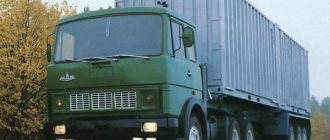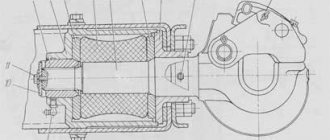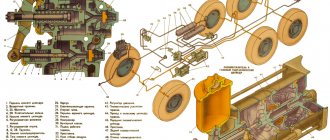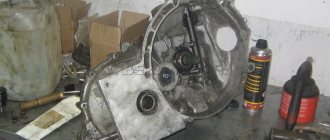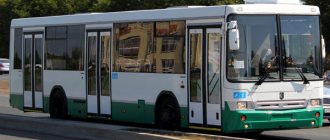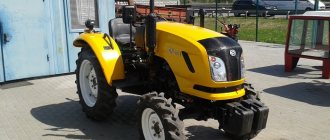Despite the rather long history of the Miass Automobile Plant, which began its existence back in 1941, the plant continues to function and even produces new cars. They will be discussed in this article – Ural 6370, manufactured in 2010. It introduces new heavy-duty vehicles with increased performance data. The Ural 6370 dump truck has an all-wheel drive system, which makes it more applicable in the Russian Federation.
In general, truck-type vehicles that have an all-wheel drive system are quite popular on various construction projects, quarries, and are also well suited for municipal and rescue services. Ural cars have increased cross-country ability on road sections where there is no direct road for driving and passage is difficult for ordinary cars. In this article you can learn about the appearance, power units, and chassis of the Ural 6370. The entire Ural model range.
general information
Serial production of the machines started in 2010. The car has a good service life - about 600,000 kilometers. The dump truck is produced in some variations, among which you can find a fuel tanker, a rear-loading dump truck, a road combination vehicle, a chassis with an extended platform for special equipment, a truck tractor to transport various types of equipment, a road train and a pipe hauler.
Appearance
A novelty in the production of the truck was a new bumper, which provided an increased increase in the front overhang and had a beveled cross-section. It has an all-metal, massive structure and, compared to other bumpers, is not very prone to damage when driving off-road. The bumper has anti-slip pads, and with the help of a folding step you can climb onto it to perform cabin maintenance.
There is also the presence of lens shockproof optics, which has high technical properties. The lighting is represented by compact modular lighting technology from Hella, which is simply excellent in use. The Ural-6370 boasts a unique two-knee rear wheel holder device, which is hydraulically driven. All this is located behind the driver's cab.
Thanks to the splash guards, it is possible to protect the drive pump. The dump truck base has rear unloading. The design staff of the plant also provided for a tailgate with exhaust gas heating. The volume of the platform reaches 16 cubic meters, the elevation angle is 50 degrees.
Scope of application, modifications and design features
A dump truck, truck tractor and chassis for special equipment of the Ural-6370 brand are designed for transporting goods, towing trailers and semi-trailers on all types of roads and rough terrain, at ambient temperatures from -45 °C to +40 °C. They are adapted for the harshest climatic conditions and intensive use; Designed for year-round storage without a garage. The manufacturer provides a warranty of 2 years or 100 thousand kilometers for all vehicles of the Ural-6370 family. The interval between scheduled maintenance is 20 thousand kilometers.
Like the classic Urals, the new cabover trucks from Miass are addressed primarily to oil and gas workers; specialists in the extraction of other minerals; military and rescue workers; builders of new roads, pipelines, wells, power lines and other facilities in hard-to-reach areas. The Ural-6370 demonstrates excellent cross-country ability wherever there is no direct plane for movement, where the passage of conventional vehicles is difficult. It can also be used as a mining dump truck in open-pit mining.
Options for this model, separated into special modifications with separate factory indices:
- Ural-6370-1121 – dump truck with a carrying capacity of 19.5 tons;
- Ural-63704-0151 – truck tractor for towing semi-trailers, with a maximum load on the fifth wheel coupling of 22 tons;
- Ural-6370-1151 – universal chassis for installing superstructures and special equipment, with a standard wheelbase;
- Ural-63701-1951 is a universal chassis for installing superstructures and special equipment, with an extended wheelbase.
Ural-6370 has an increased service life, since this model is equipped with modern imported and licensed components that meet current international quality standards:
- The YaMZ-652 diesel engine is produced by a Yaroslavl enterprise under license;
- 16-speed gearbox ZF-16S2220TD with synchronizers in all gears, from ;
- clutch “Sachs”, brand “Sachs MFZ-430”;
- "Raba Max" drive axles;
- PreLine-420 fuel coarse filters;
- modular lighting technology from Hella, which has increased impact resistance,
- three-circuit pneumatic service brake system with ABS.
- fifth wheel coupling "SAF Holland".
Ural-6370 dump trucks can be equipped with three types of dump trucks: bucket type without a tailgate; bucket type with a tailgate; straight rectangular type with a rear side. The capacity of these cargo platforms is 12, 14 and 16 cubic meters. The lifting angle of the dump truck is 50 degrees. All Ural-6370 cargo platforms are equipped with a heating system for exhaust gases from below.
Cabin
The design staff of the plant used a cabover cab, which has proven itself to be excellent. By the way, the cabin is from IVECO. The cabin has a spring suspension, which has hydraulic shock absorbers, providing the driver with comfort in a double cabin. The cabin itself turned out to be quite comfortable and the drivers’ reviews only confirm this. However, for the best thermal insulation of the cabin, it is better to get rid of the rear window, which radically takes away the heat of the cabin near the berth.
The designers of the truck-type vehicle provided for the installation of an electric drive to tilt the cab, which was present on experimental trucks. Standard vehicles boast only a hydraulic drive system for tilting the cab. Standard models were equipped with a hydraulic drive for tilting the cab, however, the designers provided for the possibility of installing an electric drive for tilting the cab.
Salon
The driver's seat has air suspension, as well as a Pilot seat. A berth is available for a 2nd driver, which is quite convenient and comfortable when driving long distances. The steering column in the Ural-6370 car is adjustable in height and tilt. The steering wheel is controlled using a hydraulic power steering wheel. The rear view mirrors can also be controlled electrically, making them very easy to adjust. In addition, the company also provided an electric heating option for them.
If we compare the car with older cars of the company, which also have an Iveco cabin, then in the new version the upholstery of the engine compartment has been changed, which has become more productive during operation. The instrument panel no longer has a large overlay; from now on there is a different overlay. Also located nearby are switches for ABS, differential locks, independent air heater, transfer case switches, and there is also a convenient system for adjusting the air pressure in the wheels. The company was able to improve the interior and parameters of the driver's seat, which includes improvements in visibility and noise insulation.
Trucks with all-wheel drive have proven themselves in the most difficult operating situations. They are not afraid of garage-free storage and can be used at temperatures from -50 to +50 degrees Celsius. The cost of these vehicles is much less than their foreign counterparts.
A modern cabover is a fundamentally new model of the Ural Automobile Plant
In 2010, Ural introduced a new, heavy-duty, all-wheel drive dump truck with improved performance qualities, the Ural 6370. Trucks with all-wheel drive are in demand when developing deposits in quarries, at construction sites of various sizes, and in the work of rescue and utility services. They have increased maneuverability on roads where there is no straight plane for movement and the passage of ordinary transport is difficult.
All-wheel drive trucks have proven themselves well in difficult operating conditions, they are still designed for garage-free storage, the Ural can be operated at temperatures from -50 to +50, and the price of these vehicles is significantly lower than their foreign counterparts.
Conveyor assembly of cars began in 2010. The truck's service life is 600,000 km. The Ural 6370 is produced in several versions: a fuel tanker, a rear-loading dump truck, a road combination vehicle, a chassis with an extended base for special equipment, a truck tractor for transporting various types of equipment, road trains, and a pipe hauler.
The Ural designers used a cabover, proven IVECO cab. The spring suspension with hydraulic shock absorbers provides the driver with comfort in the two-seater cab. The air-suspended driver's seat is equipped with a Pilot seat, and there is a berth for the second driver, which is very convenient when driving long distances.
The steering column in the truck is adjustable in tilt and height. Power steering. Electrically controlled rear-view mirrors greatly facilitate their adjustment; they are also electrically heated. In comparison with the early Ural models, which also had an IVECO cab, the upholstery of the engine compartment has changed and it has become more practical to use. There is now no massive trim on the instrument panel; it has been replaced with another one. It contains switches for ABS, differential locks, independent air heater, transfer case gears and a convenient system for adjusting the air pressure in the tires.
The driver's cabin is comfortable, customer reviews confirm this, but it would be advisable to remove the rear window. It significantly reduces the thermal insulation of the cabin where the berth is located. The dump truck designers provided for the installation of an electric drive for tilting the cab; it was available on experimental vehicles. Basic models are equipped only with hydraulic.
An innovation with the release of the Ural 6370 was a new bumper, which increased the front overhang; it has a beveled cross-section. It is all-metal, massive, and when compared with the bumpers that are installed on all-terrain vehicles, it is little damaged when the dump truck operates off-road.
The bumper is equipped with anti-slip pads, and with the help of a folding step, you can climb onto it to service the cab. Lens shockproof optics Ural 6370 has high technical characteristics - compact modular lighting equipment from Hella has proven itself in operation.
The original two-knee design of the rear wheel holder with hydraulic drive is mounted behind the driver's cabin. Mudguards protect the drive pump. YaMZ-650 is a six-cylinder diesel engine installed in the Ural 6370, assembled at the Yaroslavl plant since 2007. It was repeatedly exhibited at various exhibitions as a separate exhibit.
Specifications
The power unit is a six-cylinder diesel YaMZ-650, which has been assembled at a plant in Yaroslavl since 2007. It was exhibited many times at various exhibitions as a separate exhibit. Taking into account many design features, you understand that such an engine is not so different from the standard modification, but it has been improved, and it now meets the Euro-4 environmental standard.
This was achieved by adjusting the fuel system and electronic control unit. This power unit produces about 412 horsepower. The engine is an 11.12-liter 4-stroke with direct fuel injection, in-line cylinder arrangement, turbine and liquid cooling. The crankcase and the engine were protected below by a steel pan.
The Russian truck has proven its excellent performance on the road with a considerable amount of torque. Using a horizontal filter arrangement in a two-stage air purification system, replacing it is much easier. Taking into account the fact that the truck is used in areas with cold climates, considerable emphasis was placed on installing a “teplostart” liquid pre-heater. It provides pre-heating when parked for a long time. At a time when the temperature is very low, the heating can automatically function together with the motor simultaneously.
Transmission
The transmission is assembled from components supplied from Europe. The box has a diaphragm clutch with a hydraulic drive, as well as a pneumatic amplifier. Its model is ZF 16S2220TD. This transmission is a 16-speed mechanical transmission and one of the best in its class for similar dump trucks. The drive axles were manufactured in Hungary. The design of the rear axles was changed, which made it possible to significantly increase the tonnage of the dump truck. The main gear is spaced and has inter-axle and cross-axle differential locks.
Suspension
Ural-6370 has an original frame with alloy steel side members, which has a variable height. The suspension both front and rear received anti-roll bars, and the rear one is also balanced. The front suspension is dependent, has a pair of springs with hydraulic shock absorbers.
Steering
In the Ural 6370 it is presented with a hydraulic power steering wheel, and the steering column itself can be adjusted in height and tilt.
Brake system
The brake system of the car has a three-circuit pneumatic drive, an automatic locking service and an air preparation unit.
The fuel tank is designed for 500 liters. The vehicle has a 6x6 wheel arrangement, a maximum load capacity of 19 tons, and the dump truck itself weighs about 14,650 kg. Maximum speed at 80 km/h.
Frame, suspension and chassis
All modifications of the Ural-6370 have an original frame with alloy steel side members of variable height. Frame of variable cross-section, width at the front - 95 cm, at the rear - 77.4 cm. Spar profile of variable height, cross-sectional dimensions of the rear part - 300 x 80 x 10 mm, front part - 210 x 80 x 10 mm.
Front suspension design. Dependent, on two longitudinal few-leaf parabolic (or multi-leaf) semi-elliptic springs, operating in conjunction with two double-acting hydraulic telescopic shock absorbers; with torsion bar stabilizer bar.
Rear suspension design. Dependent, balanced, with reaction bars, on double-longitudinal semi-elliptic springs, with a torsion bar anti-roll bar mounted on the rear axle.
Wheels Ural-6370 - “11.25-20”, steel, disc, with dismountable three-component rims, with conical landing flanges 5°; centered along the central hole of the disk. Tires 16.00R20 172F, model Bel-95 (“BelShina”, Bobruisk), pneumatic, radial, adjustable pressure, with an all-terrain tread pattern. The spare wheel holder is vertical, with a movable folding bracket and a wheel mounting beam. Raising and lowering the spare wheel is carried out by a hydraulic cylinder.
Modifications
The Ural-6370 truck can be produced for various designs. For example, on the Ural 6370 chassis there is a truck tractor, a pipe hauler, a dump truck and a chassis with an extended platform for special settings. The tipper version can be used for transporting bulk construction, industrial bulk and bulk cargo, for agriculture and in general for anything that can be tipped over with the help of a body. The machine can be operated on any road surface and on different terrain.
Moreover, the Russian truck can be used in the development of mineral resources in quarries. Using the self-unloading option, the time for unloading the vehicle is significantly reduced, which serves as a clear trump card over other special vehicles with a fixed platform. Possessing such excellent characteristics, special equipment was able to occupy an honorable niche in the current truck market.
Ural-379/395 (1969 – 1973)
Ural-379/395
(1969 – 1973)
During the design process of the three-axle 5-ton army 379/395 family, a more compact cabover layout for medium and large class military vehicles still caused controversy among Soviet scientists and designers. By that time, it had not yet become widespread, although in comparison with the hood design it provided an extension of the cargo platform, a reduction in the overall length of the vehicle, a reduction in its own weight and increased maneuverability. To carry out comparative tests of prototype vehicles of both designs, a compromise decision was made to produce three-axle prototype Ural-379 (6x6) trucks in two versions - bonneted and with a cab over the engine, and fundamentally new four-axle Ural-395 vehicles - only in a cabover version.
Using the serial Ural-375D chassis and cabin from the 377 model, in July 1969 the first to be assembled was the Ural-379B hooded model with the original 3-seater cabin, expanded by 300 mm, a new tail and a rounded shortened engine compartment. In November of the same year, the cabover Ural-379A appeared with a short 3-seater cabin above the engine, manufactured in Miass. Thanks to the use of fiberglass, which was fashionable at that time, it became the main feature of the entire family. In general design, both options were identical and were equipped with an experimental four-stroke diesel engine “Ural-2E640” V8 (9.14 l, 200 hp) liquid cooled with a pre-heater, drum brakes with light indicators for lining wear, power steering, tires 14.00 - 20 with internal pressure regulation from the 375D model and AC electrical equipment, but the idea of an independent suspension could not be implemented on them. The transmission included a dry double-disc clutch, a 4-speed manual gearbox with a two-stage range, a two-stage pneumatically controlled transfer case, and original drive axles with stamped and welded crankcases. All-metal loading platforms with a loading height increased by 120 mm had a flat floor and different lengths. The overall dimensions of the 379B model with a tilt body were 7047x2612x3130 mm, ground clearance - 374 mm. Compared to the Ural-375D, the 379A cabover version with a body lengthened by 800 mm was 400 mm shorter. For the bonnet 379B these parameters were 600 and 200 mm. Their carrying capacity (5000 and 5145 kg) and curb weight (8220 and 8200 kg) were almost the same, the total weight was 13,520 and 13,645 kg, respectively.
A hooded truck "Ural-379B" on a 375D chassis with an experimental 200-horsepower diesel engine. 1969
Factory and military tests of both vehicles, carried out until the end of 1971, proved the conceptual superiority of the 379A model, but visibility in the rear direction was reduced by doors that opened against the vehicle, and the labor intensity of maintenance significantly increased the need to tilt the cab forward using a winch. Both cars developed the same maximum speed of 86 km/h, overcame inclines of up to 30?, a side roll of 20?, a ford with a depth of 1.5 m and had a power reserve of 800 km. The total weight of the trailer towed on the ground did not exceed 6.8 tons. In general, they did not significantly exceed the Ural-375D already delivered to the conveyor.
Cabover 5-ton version of the Ural-379A (6x6) with a fiberglass cab. 1970
In parallel with two-axle vehicles, since the late 1960s, the first four-axle army truck "Ural-395" (8x8) with a payload of 8.5 tons, a cabin over the engine and all single wheels, unified with the 379 series, was created on its own at the Ural plant. In 1972, the first prototype appeared with an experimental YaMZ-741 V10 diesel engine (13.6 l, 260 hp), which the Yaroslavl Motor Plant was developing for the future generation of KamAZ trucks. The transmission included an 8-speed gearbox and a two-speed transfer case, both pneumatically controlled. The car was equipped with a balanced suspension of all wheels, power steering, tire pressure regulation, a winch and a low-sided all-metal tilt cargo platform with internal dimensions of 5550x2260 mm. The fiberglass cabin was similar to the three-axle cabovers. The overall dimensions of the car were 8304x2500x2800 mm, ground clearance - 400 mm. Curb weight – 10,620 kg, gross – 19,320 kg. The truck towed a 9-ton trailer, had a top speed of 75 km/h, climbed 30 degrees and had a range of 1,000 km. Its tests continued until 1973.
Cabover 8.5-ton truck “Ural-395 (8×8) with a 10-cylinder diesel engine. 1972
A unique floating vehicle “Ural-379P” with propellers and a metal cabin. 1972
In the early 1970s, based on the 379A and 395 vehicles, the design and production of secret samples of fundamentally new army amphibians began with a lifting capacity afloat of 4 and 7 tons, respectively, with a speed on water of 4 - 6 km/h. Outwardly, they were almost no different from ordinary trucks and in the open press they had the designations “Ural-379P” and “Ural-395P”. For the first time in the world, they implemented the principle of using a conventional land army vehicle, on which, with minimal modifications to the chassis, for movement afloat, two three-blade propellers were mounted, openly located on both sides of the frame under the rear of the cargo platform. They were driven from the car's power take-off. Buoyancy was provided by a spacious all-metal body (monocoque load-bearing body) with high non-folding steel side walls and a sealed rear hinged side. For this purpose, the previous lightweight plastic cabins were no longer suitable, and therefore on the floating versions they were replaced by more durable and voluminous 2-seater sealed all-metal structures with two flat windshields, which served as an additional means of increasing buoyancy. Polyurethane foam was used as a sealant, which covered the entire body, cabin and bottom, and the sealing of the chassis units corresponded to the serial Ural trucks. To further increase buoyancy, removable polyurethane foam floats were used. When moving afloat, all rotating wheels with high tire tread came to the aid of the propellers, creating additional traction force. To facilitate exit from the water onto the wet sandy and muddy shore, a winch and a centralized system were used, which reduced the internal air pressure in all tires while moving. Experimental floating cars were tested in 1972 - 1973. They were equipped with two fuel tanks, spotlights, special signals and high air intakes behind the cabin. The exact test results remain unknown, although it can be assumed that the amphibians turned out to be too heavy and unstable afloat with insufficient controllability and maneuverability in the coastal strip. But in general, already at the first stage of work in this direction, the result was achieved: from the side, floating trucks with high bodies, camouflaged with voluminous removable awnings with low-slung side panels, were almost no different from their land versions and provided the necessary secrecy of use, but required additional refinement and improving water performance. They were partially embodied in the second family “Susha”.
Floating 7-ton version of the "Ural-395P" with an onboard displacement body. 1973
Advantages and disadvantages
Pros of the car
- Fresher appearance of the truck, in line with modern style;
- Good maneuverability;
- All-wheel drive system;
- High ground clearance;
- Possibility to centrally change tire pressure;
- As a separate option, you can install an electric drive for tilting the cab (a hydraulic drive is standard equipment);
- Good maintainability;
- There are all the necessary spare parts and components;
- Recent release of dump truck;
- Available for many modifications and special purposes;
- Relatively low cost of the truck;
- Powerful power unit;
- Improved cabin noise insulation;
- Improved driver visibility;
- Good gearbox;
- Solid transportable weight;
- It is possible to heat the body using exhaust gases;
- There is a sleeping place;
- There is modular lighting equipment in front.
Cons of the car
- Russian cars are still not up to par with their European counterparts in terms of cabin comfort;
- There are many questions about the quality and assembly of the interior itself;
- Heating ducts do not extend to the sleeping area, which is why it is not always warm there;
- Uncomfortable seats;
- It is very cramped to sit, as there is little free space before the dashboard;
- High, uncomfortable gear lever;
- Interior heating;
- Lots of wasted space;
- Inconvenient handbrake;
- Tight grip;
- There are problems with the body.
Steering and brake control
The steering mechanism of the truck is of the integral type. Booster pump –
with built-in flow and pressure valve. Working gear: screw - ball nut - rack - sector. The rack serves as the piston of the amplifier mechanism.
The working brake system of the truck is with a three-circuit pneumatic brake drive, an automatic locking system and an air preparation unit. The emergency braking system is one of the circuits of the working system. Parking operating system - with four spring energy accumulators acting on the brake pads of the wheels of the rear and middle axles. Auxiliary brake system: A compression brake is installed in the exhaust system.
Let's sum it up
After a more detailed examination of the new Ural 6370 truck, mixed feelings remain. On the one hand, the truck has just recently entered production and should be clearly head and shoulders above its predecessors. However, on the other hand, in reality everything is not quite like that. There are a lot of shortcomings. There are a lot of complaints about everything that was not done in Miass. This applies to both external and internal defects.
It’s a pity that the heating system let us down, since such cars are often used in areas where the temperature is quite low. The good news is that we managed to freshen up the car at least a little, there were new lamps, an improved power unit, gearbox, starting heater and berth.
By the way, the latter is not very warm, which is why there are problems in the winter. We increased the vehicle's carrying capacity and installed the ability to heat the rear part of the body using exhaust gases, which, again, will be very useful during sub-zero weather. What else keeps the dump truck on the market is its relatively low cost and driving characteristics. It is noticeable that the company strives to be competitive and constantly wants to develop.
We advise you to read the article: “Ural” - the history of the automobile plant
Ural-6370 photo
Read further:
Ural-63685
Ural-44202
KamAZ-6520
Chevrolet Corvette C2 StingRay
KamAZ-6460
Aston Martin DB3S
